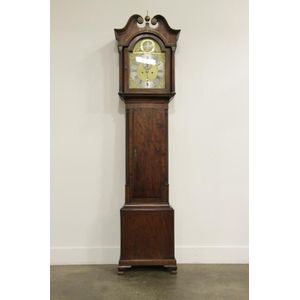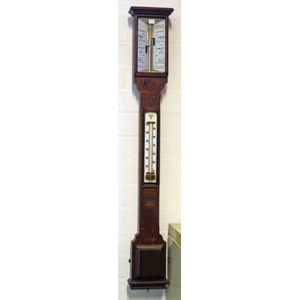Victorian Oak Stick Barometer by J. Hicks, London
You must be a subscriber, and be logged in to view price and dealer details.
Subscribe Now to view actual auction price for this item
When you subscribe, you have the option of setting the currency in which to display prices to $Au, $US, $NZ or Stg.
- Victorian Period - The Victorian period of furniture and decorative arts design covers the reign of Queen Victoria from 1837 to 1901. There was not one dominant style of furniture in the Victorian period. Designers used and modified many historical styles such as Gothic, Tudor, Elizabethan, English Rococo, Neoclassical and others, although use of some styles, such as English Rococo and Gothic tended to dominate the furniture manufacture of the period.
The Victorian period was preceded by the Regency and William IV periods, and followed by the Edwardian period, named for Edward VII (1841 ? 1910) who was King of the United Kingdom and the British Dominions and Emperor of India for the brief period from 1901 until his death in 1910. - Oak - Native to Europe and England, oak has been used for joinery, furniture and building since the beginning of the medieval civilisation. It is a pale yellow in colour when freshly cut and darkens with age to a mid brown colour.
Oak as a furniture timber was superceded by walnut in the 17th century, and in the 18th century by mahogany,
Semi-fossilised bog oak is black in colour, and is found in peat bogs where the trees have fallen and been preserved from decay by the bog. It is used for jewellery and small carved trinkets.
Pollard oak is taken from an oak that has been regularly pollarded, that is the upper branches have been removed at the top of the trunk, result that new branches would appear, and over time the top would become ball-like. . When harvested and sawn, the timber displays a continuous surface of knotty circles. The timber was scarce and expensive and was used in more expensive pieces of furniture in the Regency and Victorian periods.
This item has been included into following indexes:
- barometers, period or origin - Victorian period 113
-
barometers, type
- stick 59
- various makers and types 172
Visually similar items

Antique English oak and mahogany banded long case clock, Wm. Green, Doncaster, seconds aperture and calendar aperture, the hood with broken swan neck pediment with ebony and string inlay, approx 220 cm high, 51.5 cm wide, 24 cm deep

A George III mahogany longcase clock signed C Fenwick Crieff 1826, having a painted dial subsidiary for seconds, date aperture, with twin train movement the trunk enclosed by with waist panel door between canted corners. 214 cm high

A Swiss provincial long case clock with wood dial and roman numerals in painted soft wood case, 204 cm high

An early 19th century mahogany cased grandfather clock the brass dial with a silvered chapter ring signed Geo. Bruce London. Height 218 cm. Width 45 cm. Depth 22 cm
